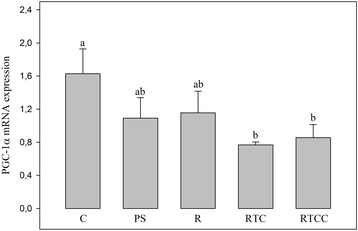Dietary canolol protects the heart against the deleterious effects induced by the association of rapeseed oil, vitamin E and coenzyme Q10 in the context of a high-fat diet
- PMID: 29456586
- PMCID: PMC5809903
- DOI: 10.1186/s12986-018-0252-4
Dietary canolol protects the heart against the deleterious effects induced by the association of rapeseed oil, vitamin E and coenzyme Q10 in the context of a high-fat diet
Abstract
Background: Obesity progressively leads to cardiac failure. Omega-3 polyunsaturated fatty acids (PUFA) have been shown to have cardio-protective effects in numerous pathological situations. It is not known whether rapeseed oil, which contains α-linolenic acid (ALA), has a similar protective effect. Omega-3 PUFAs are sensitive to attack by reactive oxygen species (ROS), and lipid peroxidation products could damage cardiac cells. We thus tested whether dietary refined rapeseed oil (RSO) associated with or without different antioxidants (vitamin E, coenzyme Q10 and canolol) is cardio-protective in a situation of abdominal obesity.
Methods: Sixty male Wistar rats were subdivided into 5 groups. Each group was fed a specific diet for 11 weeks: a low-fat diet (3% of lipids, C diet) with compositionally-balanced PUFAs; a high-fat diet rich in palm oil (30% of lipids, PS diet); the PS diet in which 40% of lipids were replaced by RSO (R diet); the R diet supplemented with coenzyme Q10 (CoQ10) and vitamin E (RTC diet); and the RTC diet supplemented with canolol (RTCC diet). At the end of the diet period, the rats were sacrificed and the heart was collected and immediately frozen. Fatty acid composition of cardiac phospholipids was then determined. Several features of cardiac function (fibrosis, inflammation, oxidative stress, apoptosis, metabolism, mitochondrial biogenesis) were also estimated.
Results: Abdominal obesity reduced cardiac oxidative stress and apoptosis rate by increasing the proportion of arachidonic acid (AA) in membrane phospholipids. Dietary RSO had the same effect, though it normalized the proportion of AA. Adding vitamin E and CoQ10 in the RSO-rich high fat diet had a deleterious effect, increasing fibrosis by increasing angiotensin-2 receptor-1b (Ag2R-1b) mRNA expression. Overexpression of these receptors triggers coronary vasoconstriction, which probably induced ischemia. Canolol supplementation counteracted this deleterious effect by reducing coronary vasoconstriction.
Conclusion: Canolol was found to counteract the fibrotic effects of vitamin E + CoQ10 on cardiac fibrosis in the context of a high-fat diet enriched with RSO. This effect occurred through a restoration of cardiac Ag2R-1b mRNA expression and decreased ischemia.
Keywords: Antioxidant; Canolol; Heart; Obesity; Rapeseed oil; ω3 PUFAs.
Conflict of interest statement
All experiments followed European Union guidelines concerning the care and use of laboratory animals for experimental and scientific purposes. All procedures involving animals and their care were approved by the INSA–Lyon Institutional Animal Care and Use Committee.All the authors have given the manuscript approval if accepted for publication in Nutrition & Metabolism.The authors declare that they have no competing interests.Springer Nature remains neutral with regard to jurisdictional claims in published maps and institutional affiliations.
Figures




Similar articles
-
Dietary supplementation of alpha-linolenic acid in an enriched rapeseed oil diet protects from stroke.Pharmacol Res. 2010 Mar;61(3):226-33. doi: 10.1016/j.phrs.2009.12.007. Epub 2009 Dec 29. Pharmacol Res. 2010. PMID: 20036742
-
Rapeseed oil fortified with micronutrients can reduce glucose intolerance during a high fat challenge in rats.Nutr Metab (Lond). 2018 Mar 20;15:22. doi: 10.1186/s12986-018-0259-x. eCollection 2018. Nutr Metab (Lond). 2018. PMID: 29568317 Free PMC article.
-
Feeding of palm oil fatty acids or rapeseed oil throughout lactation: Effects on energy status, body composition, and milk production in Norwegian dairy goats.J Dairy Sci. 2017 Sep;100(9):7588-7601. doi: 10.3168/jds.2017-12768. Epub 2017 Jul 12. J Dairy Sci. 2017. PMID: 28711245
-
Omega-3 fatty acids and antioxidants in edible wild plants.Biol Res. 2004;37(2):263-77. doi: 10.4067/s0716-97602004000200013. Biol Res. 2004. PMID: 15455656 Review.
-
Bioenergetic and antioxidant properties of coenzyme Q10: recent developments.Mol Biotechnol. 2007 Sep;37(1):31-7. doi: 10.1007/s12033-007-0052-y. Mol Biotechnol. 2007. PMID: 17914161 Review.
Cited by
-
EPA is Cardioprotective in Male Rats Subjected to Sepsis, but ALA Is Not Beneficial.Antioxidants (Basel). 2020 Apr 29;9(5):371. doi: 10.3390/antiox9050371. Antioxidants (Basel). 2020. PMID: 32365668 Free PMC article.
-
Dietary EPA Increases Rat Mortality in Diabetes Mellitus, A Phenomenon Which Is Compensated by Green Tea Extract.Antioxidants (Basel). 2019 Nov 4;8(11):526. doi: 10.3390/antiox8110526. Antioxidants (Basel). 2019. PMID: 31690052 Free PMC article.
-
Oxidative Stress and Obesity- and Type 2 Diabetes-Induced Heart Failure.Antioxidants (Basel). 2020 Jul 23;9(8):653. doi: 10.3390/antiox9080653. Antioxidants (Basel). 2020. PMID: 32717814 Free PMC article.
-
Comparison of coenzyme Q10 or fish oil for prevention of intermittent hypoxia-induced oxidative injury in neonatal rat lungs.Respir Res. 2021 Jul 5;22(1):196. doi: 10.1186/s12931-021-01786-w. Respir Res. 2021. PMID: 34225702 Free PMC article.
-
Effect of Rosmarinic Acid and Sinapic Acid on Oxidative Stress Parameters in the Cardiac Tissue and Serum of Type 2 Diabetic Female Rats.Antioxidants (Basel). 2019 Nov 22;8(12):579. doi: 10.3390/antiox8120579. Antioxidants (Basel). 2019. PMID: 31771099 Free PMC article.
References
-
- Kapiotis S, Holzer G, Schaller G, Haumer M, Widhalm H, Weghuber D, Jilma B, Roggla G, Wolzt M, Widhalm K, et al. A proinflammatory state is detectable in obese children and is accompanied by functional and morphological vascular changes. Arterioscler Thromb Vasc Biol. 2006;26(11):2541–2546. doi: 10.1161/01.ATV.0000245795.08139.70. - DOI - PubMed
-
- Mourmoura E, Chate V, Couturier K, Laillet B, Vial G, Rigaudiere JP, Morio B, Malpuech-Brugere C, Azarnoush K, Demaison L. Body adiposity dictates different mechanisms of increased coronary reactivity related to improved in vivo cardiac function. Cardiovasc Diabetol. 2014;13:54. doi: 10.1186/1475-2840-13-54. - DOI - PMC - PubMed
LinkOut - more resources
Full Text Sources
Other Literature Sources

